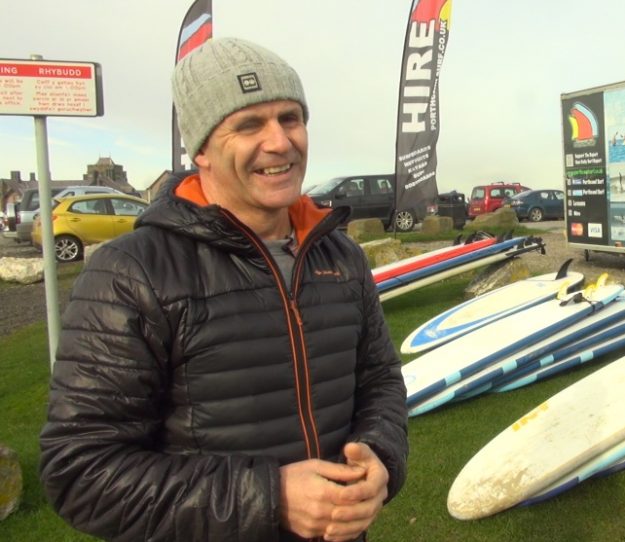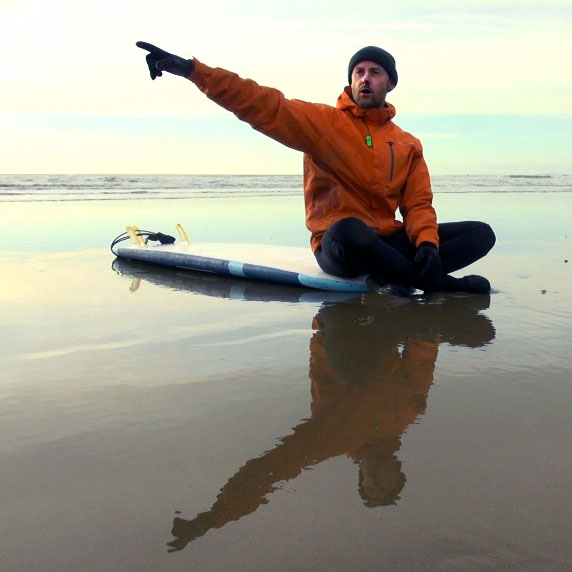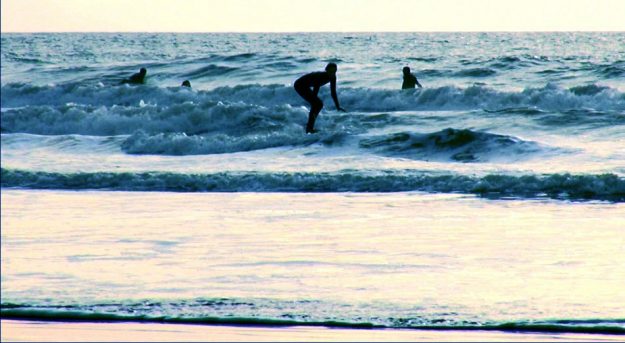What is it about surfing that keeps locals hitting the waves, even in wintery waters?
Porthcawl is a sea-side village in South Wales. Here, surfing is a way of life and it doesn’t really matter what month it is. You can even get surfing lessons in the winter through Porthcawl Surf School. With their guidance, I decided to brave it for a day and see for myself why anyone would ever go surfing in winter.
It’s a Sunday afternoon, hosting an unforgiving windchill. The folks at the surf school hand me a wet-suit and point me in the direction of a public toilet.
The task seems easy enough. You’re just putting on a body suit, after all. It’s not. I knock into the walls of a stall for about ten minutes, before checking with a stranger, whose son happens to surf, to make sure the zipper at the back was behaving right.
“Is this supposed to happen?” I ask Max Alesbury, the instructor, back at the rental shop as I demonstrate how stiffly my knees bend.
“Yeah, that’s normal,” he says.
Winter wet-suits are two to three centimeters thick, for insulation. The added padding makes for rigid rmovements on land, but saves you the full brunt of chilling waves once you’re in the ocean.

“We get the best surf in the winter,” Hugh Murray says. He’s the owner and head coach of Porthcawl Surf School. “The best time to surf in this country is from September through to about April.”
You also have the benefit of fewer crowds in winter months, but it would be ill-advised to go alone.
“You don’t need to buddy up with a better or more experienced surfer, you just need to buddy up with someone so that you’re not in there on your own,” Hugh says.
Once you’ve adorned yourself with gloves, boots and a funny-looking cap, (all necessary to keep you warm, I was told) its time to wax your surfboard.
Waxing a board allows you to grip onto it better, which helps when you’re riding waves and trying to stand at the same time. Though that’s not even the most tiring part of surfing.
The board I used had a top-layer of foam, making it more buoyant. This type of surfboard is recommended for beginners. It’s easy on the knees and provides more stability than advanced boards.
Walking up to the water’s edge, I looked out at the instructor and the other beginners now in the water. “Am I really doing this?” I thought as I kept my stride into the first wave. Then, a strange sensation hit me. I could feel the force of the water, but not the temperature of it. A blessing, since it was about six degrees Celsius (43 degrees Fahrenheit).

Once you get moving, you warm up quickly, but one feeling I couldn’t shake was the ache in my legs. The more I walked against the current, the more my muscles burned.
We had been practicing catching waves in the sand. When you catch a wave, you push forward as you lie flat against the board.
The technique is important, but it’s useless if you don’t have the timing right. On my first go, I got ahead of myself and pushed off too soon. I felt the wave push through me.
As I watched it roll ahead of me, I wondered just how impossible this was going to be.
It didn’t take too long before I was riding waves like a seal to the shore, more often shooting horizontally along the surf. As it turns out, if you’re not fully on the board, the balance goes off and you’re turning yourself ways you don’t want to go. At that point. Max, the instructor, blew his whistle and signlaled for us to get ourselves out of the water. We were about to learn how to stand up on the board.
As it turns out, if you’re not fully on the board, the balance goes off and you’re turning yourself ways you don’t want to go. At that point. Max, the instructor, blew his whistle and signlaled for us to get ourselves out of the water. We were about to learn how to stand up on the board.
It’s reminiscent of yoga. You start lying down, as you were when you caught the wave, and then you go into a lunge and from there into the surfer’s stance, or ‘warrior two’ if you’re a yogi.
If you’ve got that down, maybe you won’t go flying backward into the water. I did. It’s not uncommon, either. It took four tries before I successfully surfed a wave. It was a rushing sensation of elation. I got it. I got why this was such a loved sport, even in winter.
Surfer’s high, like runner’s high, is an incredible feeling.

Once you’re done surfing, change as quickly as you can. Otherwise, you put yourself at risk of hypothermia. Expect to be hungry, too.
If you are keen to try it out, a lesson at Porthcawl costs £30 for two hours. If you don’t need the lesson, and want to team up with someone, the social media network @surfsenioritas is one way for UK-based female surfers, in particular, to connect with a buddy or group to go surfing.
“It’s set up by women, or girls, for women,” Hugh says. “So that if someone wants to come down surfing, so they’re not surfing by themselves, they just put a post on there, ‘I’m going surfing, anyone want to come?'”
The only deterrent comes down to weather safety. If the winds are too strong, surfboards can be lifted up from the water and sent spinning into you or another person. If the waves are too strong, you could be sucked under.
It follows for any outdoor sport. Don’t run in a lightning storm, don’t kick a football in hail, don’t go surfing if the waves are torrential.
Curious for more? Check out these other articles:
